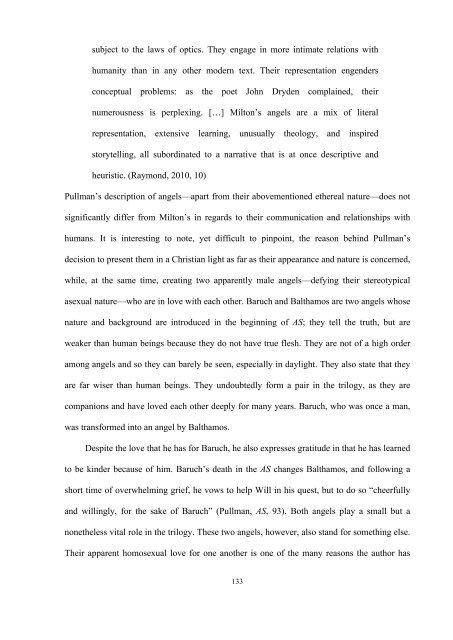The secular angel in contemporary children's literature: David ...
The secular angel in contemporary children's literature: David ...
The secular angel in contemporary children's literature: David ...
You also want an ePaper? Increase the reach of your titles
YUMPU automatically turns print PDFs into web optimized ePapers that Google loves.
subject to the laws of optics. <strong>The</strong>y engage <strong>in</strong> more <strong>in</strong>timate relations with<br />
humanity than <strong>in</strong> any other modern text. <strong>The</strong>ir representation engenders<br />
conceptual problems: as the poet John Dryden compla<strong>in</strong>ed, their<br />
numerousness is perplex<strong>in</strong>g. […] Milton’s <strong>angel</strong>s are a mix of literal<br />
representation, extensive learn<strong>in</strong>g, unusually theology, and <strong>in</strong>spired<br />
storytell<strong>in</strong>g, all subord<strong>in</strong>ated to a narrative that is at once descriptive and<br />
heuristic. (Raymond, 2010, 10)<br />
Pullman’s description of <strong>angel</strong>s—apart from their abovementioned ethereal nature—does not<br />
significantly differ from Milton’s <strong>in</strong> regards to their communication and relationships with<br />
humans. It is <strong>in</strong>terest<strong>in</strong>g to note, yet difficult to p<strong>in</strong>po<strong>in</strong>t, the reason beh<strong>in</strong>d Pullman’s<br />
decision to present them <strong>in</strong> a Christian light as far as their appearance and nature is concerned,<br />
while, at the same time, creat<strong>in</strong>g two apparently male <strong>angel</strong>s—defy<strong>in</strong>g their stereotypical<br />
asexual nature—who are <strong>in</strong> love with each other. Baruch and Balthamos are two <strong>angel</strong>s whose<br />
nature and background are <strong>in</strong>troduced <strong>in</strong> the beg<strong>in</strong>n<strong>in</strong>g of AS; they tell the truth, but are<br />
weaker than human be<strong>in</strong>gs because they do not have true flesh. <strong>The</strong>y are not of a high order<br />
among <strong>angel</strong>s and so they can barely be seen, especially <strong>in</strong> daylight. <strong>The</strong>y also state that they<br />
are far wiser than human be<strong>in</strong>gs. <strong>The</strong>y undoubtedly form a pair <strong>in</strong> the trilogy, as they are<br />
companions and have loved each other deeply for many years. Baruch, who was once a man,<br />
was transformed <strong>in</strong>to an <strong>angel</strong> by Balthamos.<br />
Despite the love that he has for Baruch, he also expresses gratitude <strong>in</strong> that he has learned<br />
to be k<strong>in</strong>der because of him. Baruch’s death <strong>in</strong> the AS changes Balthamos, and follow<strong>in</strong>g a<br />
short time of overwhelm<strong>in</strong>g grief, he vows to help Will <strong>in</strong> his quest, but to do so “cheerfully<br />
and will<strong>in</strong>gly, for the sake of Baruch” (Pullman, AS, 93). Both <strong>angel</strong>s play a small but a<br />
nonetheless vital role <strong>in</strong> the trilogy. <strong>The</strong>se two <strong>angel</strong>s, however, also stand for someth<strong>in</strong>g else.<br />
<strong>The</strong>ir apparent homosexual love for one another is one of the many reasons the author has<br />
133
















